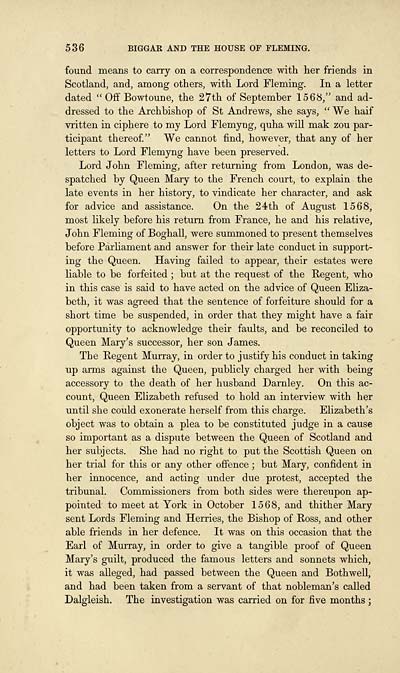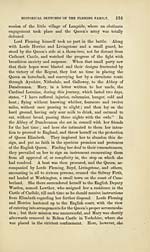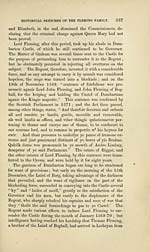Biggar and the House of Fleming
(566) Page 548
Download files
Complete book:
Individual page:
Thumbnail gallery: Grid view | List view

536 BIGGAR AND THE HOUSE OF FLEMING.
found means to carry on a correspondence with her friends in
Scotland, and, among others, with Lord Fleming. In a letter
dated " Off Bowtoune, the 27th of September 156b," and ad-
dressed to the Archbishop of St Andrews, she says, " We haif
vritten in ciphere to my Lord Flemyng, quha will mat zou par-
ticipant thereof." We cannot find, however, that any of her
letters to Lord Flemyng have been preserved.
Lord John Fleming, after returning from London, was de-
spatched by Queen Mary to the French court, to explain the
late events in her history, to vindicate her character, and ask
for advice and assistance. On the 24th of August 1568,
most likely before his return from France, he and his relative,
John Fleming of Boghall, were summoned to present themselves
before Parliament and answer for their late conduct in support-
ing the Queen. Having failed to appear, their estates were
liable to be forfeited ; but at the request of the Regent, who
in this case is said to have acted on the advice of Queen Eliza-
beth, it was agreed that the sentence of forfeiture should for a
short time be suspended, in order that they might have a fair
opportunity to acknowledge their faults, and be reconciled to
Queen Mary's successor, her son James.
The Regent Murray, in order to justify his conduct in taking
up arms against the Queen, publicly charged her with being
accessory to the death of her husband Darnley. On this ac-
count, Queen Elizabeth refused to hold an interview with her
until she could exonerate herself from this charge. Elizabeth's
object was to obtain a plea to be constituted judge in a cause
so important as a dispute between the Queen of Scotland and
her subjects. She had no right to put the Scottish Queen on
her trial for this or any other offence ; but Mary, confident in
her innocence, and acting under due protest, accepted the
tribunal. Commissioners from both sides were thereupon ap-
pointed to meet at York in October 1568, and thither Mary
sent Lords Fleming and Herries, the Bishop of Ross, and other
able friends in her defence. It was on this occasion that the
Earl of Murray, in order to give a tangible proof of Queen
Mary's guilt, produced the famous letters and sonnets which,
it was alleged, had passed between the Queen and Bothwell,
and had been taken from a servant of that nobleman's called
Dalgleish. The investigation was carried on for five months ;
found means to carry on a correspondence with her friends in
Scotland, and, among others, with Lord Fleming. In a letter
dated " Off Bowtoune, the 27th of September 156b," and ad-
dressed to the Archbishop of St Andrews, she says, " We haif
vritten in ciphere to my Lord Flemyng, quha will mat zou par-
ticipant thereof." We cannot find, however, that any of her
letters to Lord Flemyng have been preserved.
Lord John Fleming, after returning from London, was de-
spatched by Queen Mary to the French court, to explain the
late events in her history, to vindicate her character, and ask
for advice and assistance. On the 24th of August 1568,
most likely before his return from France, he and his relative,
John Fleming of Boghall, were summoned to present themselves
before Parliament and answer for their late conduct in support-
ing the Queen. Having failed to appear, their estates were
liable to be forfeited ; but at the request of the Regent, who
in this case is said to have acted on the advice of Queen Eliza-
beth, it was agreed that the sentence of forfeiture should for a
short time be suspended, in order that they might have a fair
opportunity to acknowledge their faults, and be reconciled to
Queen Mary's successor, her son James.
The Regent Murray, in order to justify his conduct in taking
up arms against the Queen, publicly charged her with being
accessory to the death of her husband Darnley. On this ac-
count, Queen Elizabeth refused to hold an interview with her
until she could exonerate herself from this charge. Elizabeth's
object was to obtain a plea to be constituted judge in a cause
so important as a dispute between the Queen of Scotland and
her subjects. She had no right to put the Scottish Queen on
her trial for this or any other offence ; but Mary, confident in
her innocence, and acting under due protest, accepted the
tribunal. Commissioners from both sides were thereupon ap-
pointed to meet at York in October 1568, and thither Mary
sent Lords Fleming and Herries, the Bishop of Ross, and other
able friends in her defence. It was on this occasion that the
Earl of Murray, in order to give a tangible proof of Queen
Mary's guilt, produced the famous letters and sonnets which,
it was alleged, had passed between the Queen and Bothwell,
and had been taken from a servant of that nobleman's called
Dalgleish. The investigation was carried on for five months ;
Set display mode to:
![]() Universal Viewer |
Universal Viewer | ![]() Mirador |
Large image | Transcription
Mirador |
Large image | Transcription
Images and transcriptions on this page, including medium image downloads, may be used under the Creative Commons Attribution 4.0 International Licence unless otherwise stated. ![]()
| Histories of Scottish families > Biggar and the House of Fleming > (566) Page 548 |
|---|
| Permanent URL | https://digital.nls.uk/94846074 |
|---|
| Description | A selection of almost 400 printed items relating to the history of Scottish families, mostly dating from the 19th and early 20th centuries. Includes memoirs, genealogies and clan histories, with a few produced by emigrant families. The earliest family history goes back to AD 916. |
|---|

